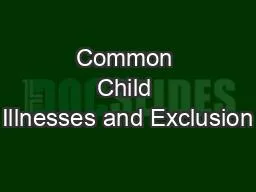

52021Criteria for Educationand Child Care SettingsA child should be temporarily excluded from an education or child care setting when the childs illness causes one or more of the followingPrevents th ID: 892992
Download Pdf The PPT/PDF document "Common Child Illnesses and Exclusion" is the property of its rightful owner. Permission is granted to download and print the materials on this web site for personal, non-commercial use only, and to display it on your personal computer provided you do not modify the materials and that you retain all copyright notices contained in the materials. By downloading content from our website, you accept the terms of this agreement.
1 5/2021 Common Child Illnesses an
5/2021 Common Child Illnesses and Exclusion Criteria for Education and Child Care Settings A child s hould be temporarily excluded from an education or child care setting when the child’s illness causes one or more of the following: Prevents the child from participating comfortably in activities. A need for care that is greater than the staff can provide without compromising the health and safety of other children. An acute change in behavior: lethargy, lack of responsiveness, irritability, persistent crying, difficult y breathing, or a quickly spreading rash. Fever with behavior change or other signs and symptoms in a child older than 2 months (e.g., sore throat, rash, vomiting, diarrhea). For infants younger than 2 months of age, a fever with or without a behavior change or other signs and symptoms. A child with a temperature elevated above normal is not necessarily an indication of a significant health problem. A fever is defined as: For an infant or child older than 2 months, a fever is a temperature that is above 101 degrees F [38.3 degrees C] by any method. For infants younger than 2 months of age a fever is a temperature above 100.4 degrees F [38 degrees C] by any method. Temperature readings do not require adjustment for the location where the temperature is taken. In education settings please refer to your district’s policy regarding fever definition . ILLNESS EXCLUDE RETURN TO CHILD CARE /SCHOOL Chicken Pox Yes. When all blisters are crusted with no oozing (usually 6 days) and resolution of exclusion criteria. COVID - 19 Yes. 10 days after symptoms start and 24 hours with no fever and improved symptoms OR 10 days after positive test (if no symptoms) .
2 Diarrhea (infectious) Yes (there
Diarrhea (infectious) Yes (there are special exclusion rules for E.coli 0157.H7, Shigella and cryptosporidiosis). When diarrhea stops and health care provider and public health official states the child may return. 5/2021 Diarrhea (non - infectious) Yes, if stool cannot be contained in the diaper, or if toileted child has 2 or more loose stools in 24 hours, or blood in stool. When diarrhea stops and resolution of exclusion criteria. Fifth Disease No. Unless child meets other exclusion criteria. If excluded due to presence of other exclusion criteria, resolution of exclusion criteria. Hand a nd Mouth No. Unless child meets other exclusion criteria. Or is excessively drooling with mouth sores. If excluded due to presence of other exclusion criteria, resolution of exclusion criteria. Head Lice (Pediculosis) No. Unless child meets other exclusion criteria. Treatment of an active lice infestation may be delayed until the end of the day. Children do not need to miss school or child care due to head lice. Treatment recommendations can be found here: https://www.cdc.gov/parasites/lice/he ad/treatment.html Impetigo Yes, exclude at the end of the day if blisters can be covered. After child has been seen by the doctor, after 24 hours on antibiotic, and blisters are covered. Influenza Yes. When child is fever free for 24 hours and resolution of exclusion criteria. Molluscum Contagiosum No. Unless child meets other exclusion criteria. Skin disease similar to warts. Do not share towels or clothing and use good hand hygiene. MRSA No. Unless child meets other exclusion criteria. Wounds should be kept covered and gloves worn during bandage changes. Do not share towels or clothing and use good hand hygiene. Otitis Media (ear infection) No. Unless child meets other ex
3 clusion criteria. If excluded due to p
clusion criteria. If excluded due to presence of other exclusion criteria, resolution of exclusion criteria. Pertussis (Whooping Cough) Yes. Child may return after 5 days of antibiotics and resolution of exclusion criteria. Pink Eye (Conjunctivitis) No. Unless child meets other exclusion criteria. Child does not need to be excluded unless health care provider or public health official recommends exclusion. Resolution of all exclusion criteria. Ringworm No. Unless child meets other exclusion criteria. Treatment of ringworm infection may be delayed to the end of the day. Child may be readmitted after treatment has begun. Cover lesion(s) if possible. Do not share 5/2021 clothing, bedding or personal items. Strep Throat Yes. When resolution of exclusion criteria and after 24 hours of antibiotic. Vomiting Yes. When vomiting has resolved and resolution of exclusion criteria. Please refer to Caring for Our Children: National Health and Safety Performance Standards ( Online Database ) https://nrckids.org/CFOC or the Iowa Department of Public Health EPI Manual https://wiki.idph.iowa.gov/epimanual for guidance on specific diseases not included in this list. Contact your local Child Care Nurse Consultant https://idph.iowa.gov/hcci/consultants for additional information. References: American Academy of Pediatrics, American Public Health Association, National Resource Center for Health and Safety in Child C are and Early Education. CFOC Standards Online Database. Aurora, CO; National Resource Center for Health and Safety in Child Care a nd Early Education; 2020. https://nrckids.org/CFOC/Database/3.6.1.1 (Accessed on 05212021) Iowa Department of Public Health EPI Manual: Guide to Surveillance, Investigation, and Reporting. Reportable Disease Information. Revised 6/201